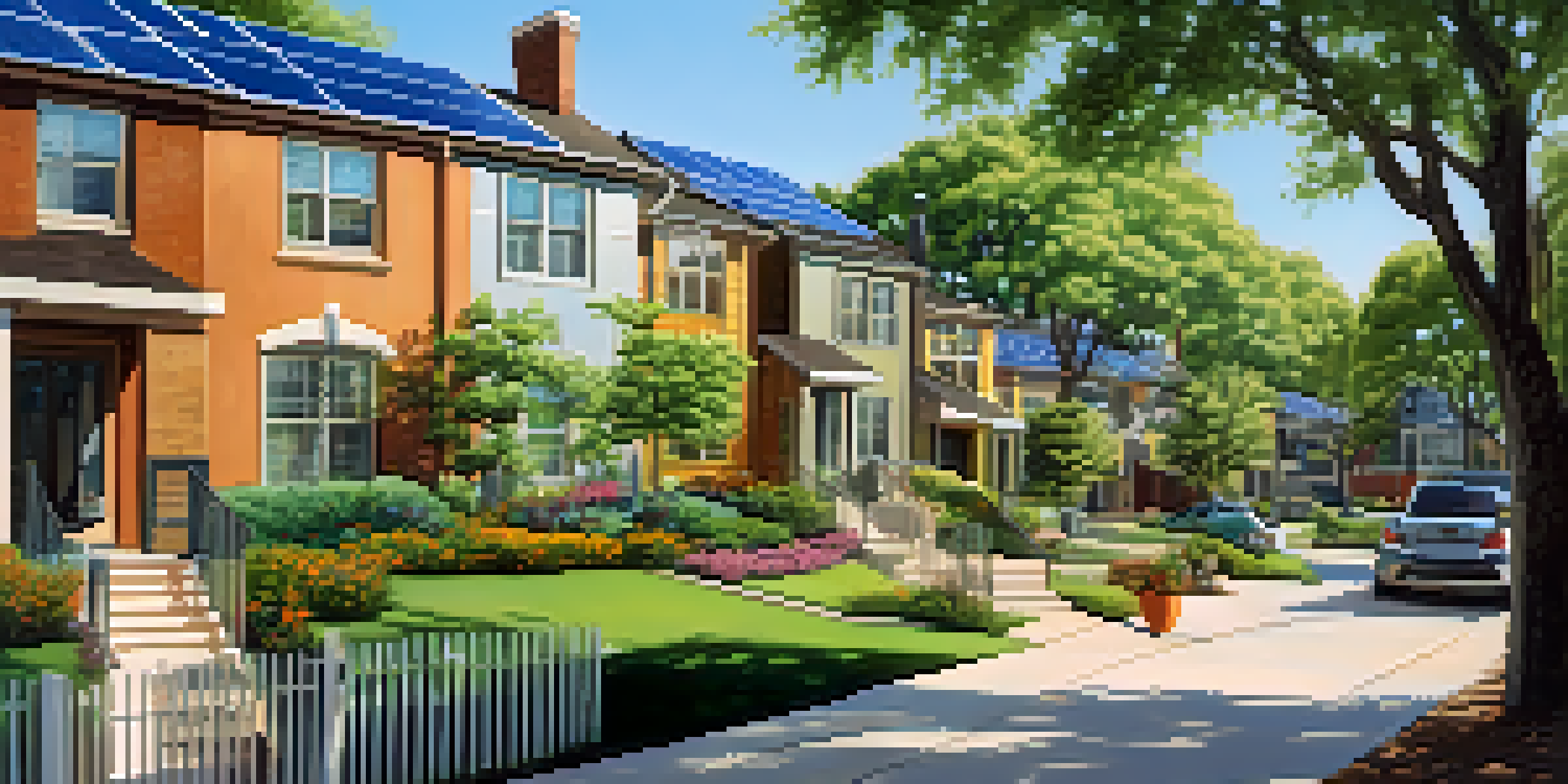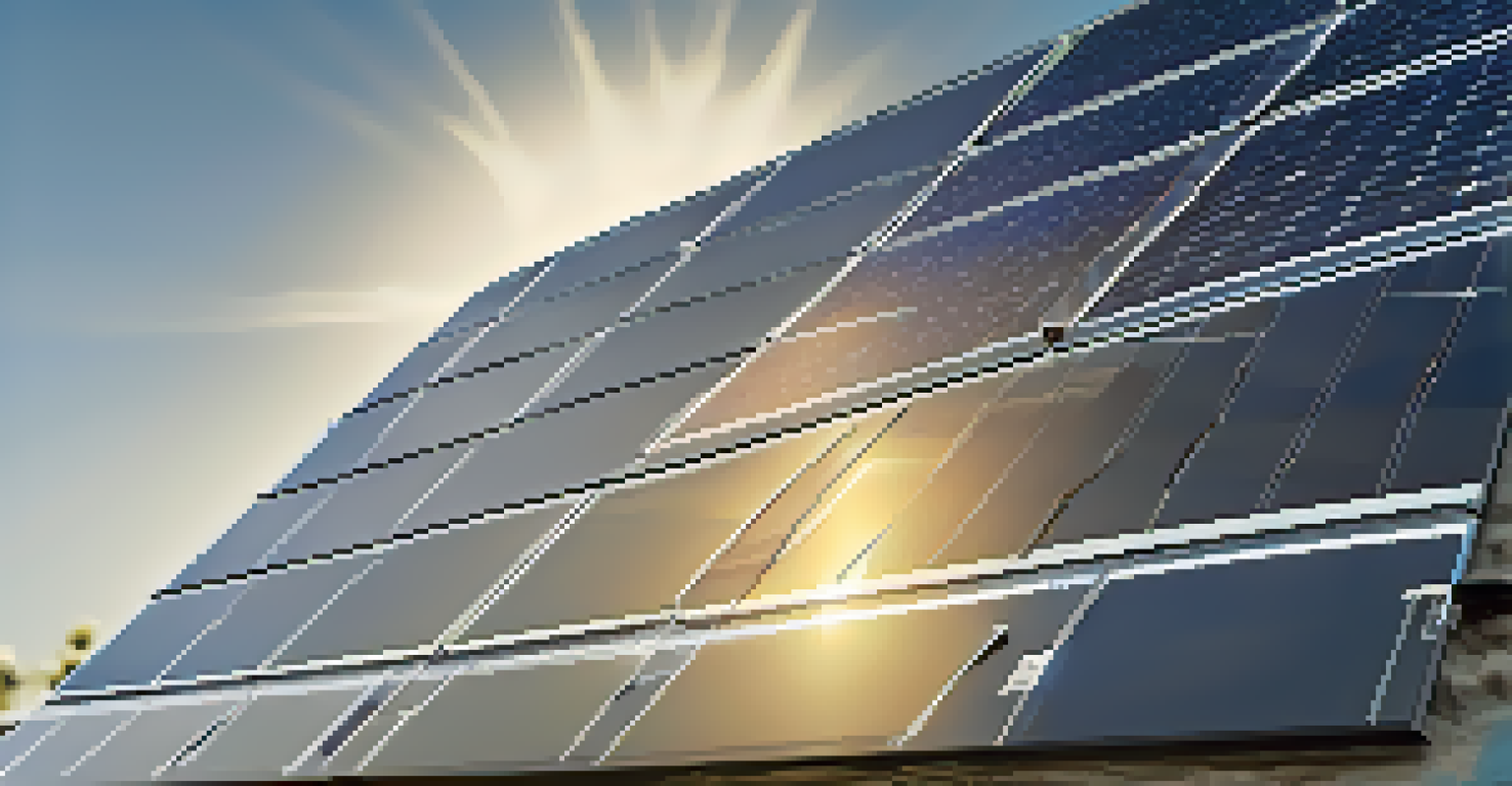The Rise of Solar Energy Adoption in Austin's Residential Areas

Understanding Solar Energy and Its Benefits for Homeowners
Solar energy harnesses sunlight to generate electricity, making it a sustainable choice for homeowners. In Austin, where the sun shines brightly, residents are increasingly turning to this renewable energy source. The primary benefit? Homeowners can significantly reduce their electricity bills while contributing to a cleaner environment.
The sun is the most powerful and abundant energy source available to us. It offers a sustainable solution for our energy needs.
Not only does solar energy lower monthly expenses, but it also increases property value. Homes equipped with solar panels are often more attractive to buyers, as they promise reduced energy costs and a commitment to sustainability. This added value is a compelling reason for many Austin residents to invest in solar technology.
Furthermore, solar energy systems can provide energy independence. Homeowners are less reliant on the fluctuating prices of traditional energy sources and can enjoy peace of mind knowing they are producing their own electricity. This aspect of solar adoption aligns perfectly with Austin's progressive and eco-conscious community.
Government Incentives Driving Solar Adoption in Austin
One of the key factors behind the rise in solar energy adoption is the range of government incentives available. Local, state, and federal programs offer tax credits and rebates, making solar installations more affordable for homeowners. In Austin, the city even provides additional incentives to further encourage residents to go solar.

For instance, the federal solar tax credit allows homeowners to deduct a significant percentage of their solar panel installation costs from their federal taxes. This financial relief can make a substantial difference for many families considering solar energy. Moreover, Austin Energy offers rebates that can help reduce upfront installation costs even more.
Solar Energy Reduces Costs
Homeowners can significantly lower their electricity bills while increasing property value by adopting solar energy.
These incentives not only make solar energy more accessible but also demonstrate the government's commitment to promoting renewable energy. As more residents learn about these benefits, the momentum for solar adoption continues to grow, fostering a sustainable future for the city.
The Role of Community Programs in Promoting Solar Energy
Community programs in Austin play a pivotal role in educating residents about solar energy. Initiatives like the Austin Solar Program offer workshops, resources, and consultations to help homeowners navigate the solar installation process. This guidance is invaluable, particularly for those new to solar energy.
Going solar is not just about saving money; it's about taking responsibility for our planet's health.
In addition to education, community programs often create group purchasing opportunities. By banding together, residents can negotiate better rates with solar providers, making installations more affordable. This collective approach not only saves money but builds a sense of community as neighbors work towards a common goal.
These programs highlight the importance of collaboration in promoting sustainable practices. As more residents participate, the demand for solar energy rises, further solidifying Austin's reputation as a leader in renewable energy adoption.
Technological Advances Making Solar Energy More Efficient
The technological advancements in solar energy have significantly improved efficiency and affordability. Innovations such as bifacial solar panels and microinverters allow homeowners to make the most of their available sunlight. These technologies are designed to capture energy more efficiently, even in less-than-ideal conditions.
Moreover, energy storage systems, like home batteries, enable homeowners to store excess energy generated during the day for use at night. This capability enhances energy independence and maximizes the benefits of solar installations. As these technologies evolve, the appeal of solar energy continues to grow.
Government Incentives Boost Adoption
Various tax credits and rebates make solar installations more affordable, encouraging more residents to transition to renewable energy.
With ongoing research and development, we can expect even more breakthroughs in solar technology. As these advancements become available, they will likely lower costs further and make solar energy an even more attractive option for Austin residents.
The Environmental Impact of Increased Solar Adoption
The rise of solar energy adoption in Austin is not just an economic decision; it's an environmental one as well. By harnessing the power of the sun, residents are significantly reducing their carbon footprint. This shift contributes to cleaner air and a healthier environment for future generations.
Solar energy systems generate electricity without producing harmful emissions, unlike fossil fuels. As more homes transition to solar, the collective impact on air quality and greenhouse gas emissions becomes increasingly significant. This aligns with the city’s goals of reducing pollution and promoting sustainability.
Additionally, as Austin continues to grow, the integration of solar energy into residential areas will help meet the increasing energy demand without further straining existing resources. This balance is crucial for maintaining a livable and sustainable urban environment.
Challenges Facing Solar Energy Adoption in Austin
Despite the many benefits, there are still challenges to widespread solar energy adoption in Austin. One significant hurdle is the initial cost of installation, which can deter some homeowners. Although incentives can help, the upfront expense remains a barrier for many families.
Moreover, some residents may have concerns about the aesthetics of solar panels on their homes. There can be a misconception that solar installations are bulky or unattractive, which might influence their decision to adopt this technology. Education and awareness are crucial in addressing these concerns.
Community Programs Enhance Awareness
Local initiatives provide education and group purchasing opportunities, fostering a collaborative approach to solar energy adoption.
Lastly, the variability of solar energy production due to weather conditions can make some homeowners hesitant. However, advancements in energy storage technology are helping to mitigate this issue, allowing for more consistent energy supply regardless of weather patterns.
The Future of Solar Energy in Austin's Residential Areas
Looking ahead, the future of solar energy in Austin's residential areas appears bright. With ongoing advancements in technology and increasing public awareness, more residents are likely to consider solar energy as a viable option. As the city continues to champion sustainability, the momentum for solar adoption will likely accelerate.
Furthermore, as Austin works towards its ambitious climate goals, solar energy will play a critical role in achieving these targets. The city's commitment to renewable energy sources positions it as a leader in the energy transition, inspiring other cities to follow suit.

In conclusion, the rise of solar energy in Austin’s residential areas is more than just a trend; it’s a movement towards a sustainable future. As more homeowners embrace this clean energy source, they contribute to a greener, healthier community for all.